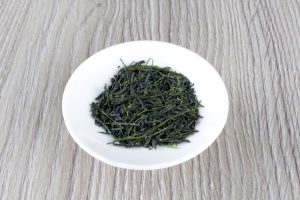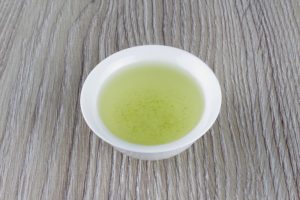This gyokuro is very interesting because it is a blend of three cultivars: Yabukita, Yamakai, and Gokou.
Furthermore, it’s made in Yame using a traditional method.
I’m happy to taste this tea sold by Ikkyu.
The leaves have a wonderful aroma. Intensely sweet and fresh, with citrus notes.
There’s no doubt that it will have a great taste as well.
Now let’s judge the leaf appearance.
Very good. Thin, tightly rolled leaves.
Let’s taste this gyokuro
While the directions say that it should be infused in water at 40ºC (104ºF), I decided to use 60ºC (140ºF) in order to have a standard for comparison.
After 2 minutes of infusion, the wet leaves have marine and vegetal notes.
The sweetness isn’t as apparent now, but it’s a pleasant aroma.
This precious liquor has a yellow-green color.
As one might expect, it’s a deep umami taste.
It has a fresh and sweet aftertaste.
Of course, it isn’t bitter nor astringent.
A delicious green tea.
Let’s make a second infusion.
I kept the same temperature, and infused for a minute and a half.
It tastes as good as the first steeping, but there is less umami taste.
For the third infusion, I increased the temperature to 70ºC (158ºF) and infused for one minute.
While this tastes better than a normal sencha, it’s lighter than the first two infusions.
Let’s make another infusion.
This time it’s 80ºC (160ºF) for just 30 seconds.
It’s also a light flavor, but with some astringency.
Well, it isn’t bad.
And so I’ll make the fifth and last infusion.
Boiling water for a few seconds.
Too light for my taste, but if felt good to extract as much of the flavor as possible.
I ate the spent leaves with some drops of ponzu sauce.
It was a satisfying experience.
Here’s the link to this tea in Ikkyu.






